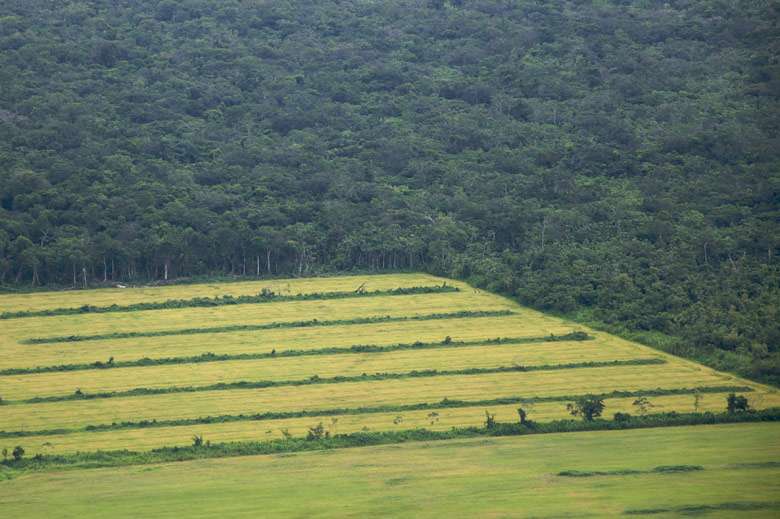Researchers seek least destructive balance of agriculture vs. forests

In the rush to feed the world's growing population, many forests may as well have a bull's-eye on them. If agricultural expansion is going to cause deforestation, does it matter where?
Cutting the same number of trees in two different locations of a forest can have vastly different impacts, according to a study co-authored by four Stanford researchers. For example, clearing habitat from within a large, intact forest can do up to four times more damage to biodiversity and carbon storage than clearing the same amount of land on the forest's edge.
"If we're going to lose more forest to agriculture, shouldn't it be in the least destructive way possible?" said study lead author Rebecca Chaplin-Kramer, a research associate at the Stanford Woods Institute for the Environment and a lead scientist at the Natural Capital Project. "Why should we lose more biodiversity or carbon storage than we need to in order to produce more food?"
Agricultural expansion
In the next 40 years, agricultural land will expand by more than 740 million acres – an area larger than India and about a third the size of the United States – according to some estimates. "With such mounting pressure and so much at stake, it is essential to find ways to meet agricultural demand while conserving critical ecosystems and minimizing overall impacts," the study's authors wrote.
Chaplin-Kramer and her co-authors focused their research, which integrated field measurements and computer simulations, on the Mato Grosso region of Brazil. The country is a "microcosm of larger global trends in agricultural development and its resulting trade-offs," the study's authors wrote.
Brazil, a biodiversity hotspot and one of the planet's largest stores of forest-based carbon, is also facing pressure for large-scale land transformation for agricultural production. It is the largest sugarcane producer and the second largest soybean producer in the world, and the area cultivated with these two crops has more than doubled in the past decade, with further increases predicted.
Conversion of forest to agriculture is most destructive when it occurs in a fragmentary pattern rather than in a consolidated patch, the study finds. Less carbon is stored in forest edges and small forest fragments because of increased tree mortality due to greater exposure to wind, fire, pests and other threats. Breaking up forests into smaller fragments can also block corridors that wildlife use to seek out food, mates and refuge. However, many policy schemes still treat an acre of a particular type of forest – regardless of its location or pattern – as having a uniform value for carbon storage and biodiversity.
Strategic solutions
According to the researchers, expanding agriculture into adjacent land rather than fragmenting forest reduces impacts by more than three times for biodiversity – or an order of magnitude for carbon storage for the same increase in agricultural area. Even something as simple as gradually spreading into a forest as opposed to jumping ahead beyond the current forest edge can cut the losses to carbon or biodiversity in half for the same amount of forest converted.
"We need to move beyond thinking about habitat as a commodity that can be traded off against another habitat," Chaplin-Kramer said. "We need to think about the context in which that habitat is found and what is at stake if it is lost."
The paper's authors suggest that governments, corporations and other stakeholders consider these factors in the creation of carbon-trading schemes, sustainability assessments, agricultural zoning, development mitigation and other decisions. Specifically, the researchers suggest policies that encourage expansion around existing agriculture or edges of forests, as opposed to large infrastructure efforts such as roads that leapfrog agricultural development into frontier habitats.
Natural Capital Project researchers are translating data from this and related studies into free software tools. Many of the study's authors work in collaboration with the Natural Capital Project, a joint initiative of the Stanford Woods Institute for the Environment, The Nature Conservancy, the University of Minnesota Institute on the Environment, and the World Wildlife Fund.
"These tools will make it easier for governments and businesses to do better environmental accounting and to understand the effects of different policies or strategies," said co-author Lisa Mandle, a Stanford Woods Institute research associate and Natural Capital Project senior scientist.
Such tools, she explained, could inform decisions about where to avoid sourcing commodities and how much carbon storage is likely to be lost as a consequence of agricultural expansion.
More information: "Spatial Patterns of Agricultural Expansion Determine Impacts on Biodiversity and Carbon Storage," PNAS, www.pnas.org/content/112/24/7402
Journal information: Proceedings of the National Academy of Sciences
Provided by Stanford University
















